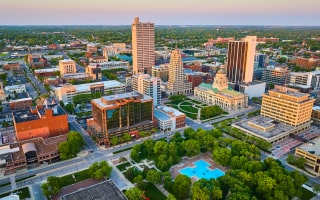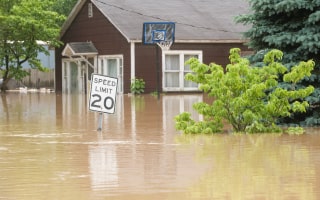Home Buying in Indiana

Indiana, known as the "Crossroads of America", offers a variety of living environments, each with its unique appeal. Whether you're drawn to the urban vibrancy of Indianapolis, the historic charm of towns like Bloomington, or the peaceful rural landscapes near the Ohio River or Lake Michigan, Indiana has something to offer every homebuyer. The state is renowned for its affordability, Midwestern hospitality, and strong economy anchored by manufacturing and agriculture.
While Indiana's lower cost of living makes it an attractive option, the state's housing market is competitive, particularly in growing urban centers like Indianapolis and Fort Wayne. These areas, driven by job growth and demand from young professionals and families, are experiencing increased competition and rising home prices. On the other hand, rural regions offer more affordable housing options, which appeal to first-time homebuyers and those looking for more space.
The median home price in Indiana sits around $250,000, significantly below the national average and below the median price in neighboring states. However, metropolitan areas and rapidly growing cities tend to have higher price points compared to rural communities. Houses typically sell within 23 days of being listed. Despite this, Indiana remains one of the most affordable states in the Midwest, attracting both out-of-state buyers and local residents looking to upgrade. Homebuyers should also consider regional differences in property taxes and potential weather-related impacts, such as severe storms or flooding in certain areas.
Indiana's population and housing market have seen steady growth, with cities like Indianapolis, Fort Wayne, and South Bend leading the charge. Indianapolis, the state's largest city, attracts young professionals due to its robust job market in sectors like healthcare and technology. Meanwhile, the scenic areas near Lake Michigan and along the Ohio River are increasingly popular among retirees and vacation home buyers. However, the rising demand in these areas has contributed to a seller's market, making it important for buyers to be prepared with strong financing and ready to move quickly.
Working with a knowledgeable real estate professional is essential when purchasing a home in Indiana. They can help you navigate the market, understand local trends, and secure the perfect property. Before starting your search, it's beneficial to research the area and ensure your finances are in order so you're ready to act in a competitive seller's market.
Current Indiana Housing Trends
Understanding Indiana's current housing market trends is critical for homebuyers seeking the right location and property.
Here are some important ones:
-
Median Home Price
The median home price in Indiana is around $250,000, making it one of the most affordable housing markets in the U.S. Prices vary significantly depending on location. In Indianapolis, the state's largest city, the median home price is slightly higher, driven by increasing demand in the growing tech and healthcare sectors. In smaller towns or rural areas, such as Evansville or Terre Haute, home prices can dip below $180,000.
-
Number of Homes Sold
Indiana sees about 7,500 homes sold monthly, with most transactions occurring in cities like Indianapolis, Fort Wayne, and South Bend. The state's housing market remains active throughout the year, although home sales peak during the warmer months when families prefer to move.
-
Median Days on Market (DOM)
Homes in Indiana typically stay on the market for an average of 23 days. However, homes may sell within just a week in cities like Indianapolis and Carmel due to higher demand and competitive prices. In rural areas, properties may remain on the market longer, giving buyers more time to explore options.
-
Housing Supply Statistics
Like many states, Indiana faces a shortage of available homes, particularly in high-demand areas like Indianapolis and its surrounding suburbs. The state currently has around a 2.5-month supply of homes, below the balanced market level of five to six months. This has increased buyer competition, particularly in sought-after neighborhoods near employment hubs.
How to Find the Right Home in Indiana

Finding the right home in Indiana requires thoughtful consideration of location, housing type, and lifestyle preferences. Working with a real estate agent who understands Indiana's local market is crucial to making an informed decision. Communicating openly with your real estate professional about your goals and finances is essential to ensuring a smooth home search process.
Finding the Right Home
When looking for a home in Indiana, several key factors should influence your decision, including:
Location
Indiana offers a variety of living environments, each with its unique appeal. Indiana has plenty to offer, whether you prefer the hustle and bustle of a city or the quiet of rural living.
-
Urban vs. Suburban vs. Rural: Major cities like Indianapolis, Fort Wayne, and South Bend provide access to employment opportunities, cultural amenities, and public transportation. Suburban areas such as Carmel, Fishers, and Greenwood are known for their family-friendly communities, top-rated schools, and proximity to city centers. Rural areas like Brown County or the Amish regions of northern Indiana offer affordability and scenic beauty for those seeking a slower-paced lifestyle.
-
Proximity to Work: Indiana's economy is largely driven by manufacturing, agriculture, and healthcare. Proximity to employment hubs like Indianapolis or Fort Wayne is important for those working in these sectors. Suburban areas like Zionsville and Avon provide easy access to downtown Indianapolis while offering a quieter, family-friendly environment. Rural areas provide affordable living, but buyers should consider commute times, especially if they work in larger cities.
-
Public Transportation: Indiana's public transportation system is limited outside major cities. Indianapolis offers IndyGo buses, and South Bend has a regional bus system, but most residents rely on cars. Living near major highways like I-465, I-69, or I-70 is important for those who prefer a shorter commute.
-
Property Taxes: Indiana's property tax rate averages around 0.85%, lower than the national average. Property tax rates vary by county, with higher rates in urban areas like Indianapolis and lower rates in rural parts of the state. Research local property taxes when deciding where to buy, as they can significantly impact the cost of homeownership.
Home Types
Indiana's housing market offers various home types, from historic homes in small towns to modern developments in growing suburbs.
-
Single-Family Homes: Single-family homes are the most common type of housing in Indiana, especially in suburban and rural areas. These homes offer space, privacy, and large yards, making them ideal for families. Many homes in suburban developments feature modern amenities, while older homes in cities like Indianapolis and Fort Wayne often have classic architectural styles like Craftsman or Colonial.
-
Condos and Townhomes: Condos and townhomes are more common in urban areas like Indianapolis, particularly downtown, and provide a low-maintenance lifestyle. Condos often come with amenities such as fitness centers and shared outdoor spaces. Townhomes in urban and suburban settings offer more space than condos but with fewer responsibilities than single-family homes.
-
Historic and Rural Homes: Indiana has numerous historic properties, particularly in small towns like Madison and New Harmony. These homes offer charm and character but often require more maintenance and upkeep. For buyers interested in rural properties, there are plenty of options for homes with large plots of land, perfect for those seeking a quieter lifestyle or interested in farming and agriculture.
The Home Buying Process in Indiana
Buying a home in Indiana is straightforward but requires careful planning.
Here are the steps:
- Get prequalified for a mortgage.
- Find a local real estate agent.
- Make an offer.
- Schedule a home inspection.
- Close on your new home.
Financing Your Indiana Home Purchase

Indiana homebuyers have several financing options available, including traditional mortgages and government-backed loans.
![]() Traditional Mortgages
Traditional Mortgages
There are two main types of traditional mortgage options available to Indiana homebuyers:
- Fixed-Rate Mortgages: Fixed-rate mortgages offer consistent monthly payments with a set interest rate over the life of the loan, making them ideal for buyers who plan to stay in their homes long-term.
- Adjustable-Rate Mortgages (ARMs): ARMs offer lower initial interest rates, which can benefit buyers who plan to sell or refinance within a few years. However, the interest rate may increase after the initial period.
Leading lenders in Indiana, such as Fifth Third Bank and Old National Bank, are popular among homebuyers for securing traditional mortgages. These financial institutions are known for offering competitive rates and a variety of mortgage options tailored to meet the needs of Indiana residents. With a strong local presence and a reputation for personalized service, they are trusted choices for those looking to finance their home purchase in the state.
![]() Government-Backed Loans
Government-Backed Loans
In addition to traditional mortgages, Indiana homebuyers have access to several government-backed loan programs:
- Indiana Housing and Community Development Authority (IHCDA) Loans: The IHCDA offers programs like the First Step and Next Home programs, providing down payment assistance and competitive mortgage rates to eligible buyers.
- FHA Loans: Backed by the Federal Housing Administration, FHA loans are designed for buyers with lower credit scores and smaller down payments.
- VA Loans: Available to veterans and active-duty military members, VA loans offer competitive interest rates and often require no down payment.
- USDA Loans: USDA loans are available for buyers in rural areas and offer low-interest financing with no down payment required. Many rural parts of Indiana qualify for these loans, making them an attractive option for buyers outside urban areas.
![]() Down Payment Assistance Programs
Down Payment Assistance Programs
Indiana offers several down payment assistance programs to help make homeownership more affordable, particularly for first-time buyers. The IHCDA provides grants and loans to help cover down payments and closing costs for eligible buyers.
Home Insurance in Indiana

Home insurance is essential in Indiana, particularly for homes in rural areas that may face risks like tornadoes or flooding. The average annual cost of home insurance in Indiana is around $1,600, though this can vary depending on the location and value of the home. Buyers in flood-prone areas, particularly near rivers, may need additional flood insurance.
Home Buying Challenges in Indiana
While Indiana offers affordable housing, there are some challenges that buyers may face:
-
Rising Home Prices: Home prices in Indiana have increased, particularly in popular areas like Indianapolis and Carmel. This trend has made it more difficult for first-time buyers to enter the Indiana housing market.
-
Limited Inventory: Indiana, like many states, faces a housing shortage, especially in suburban and rural areas where new construction has not kept pace with demand. Buyers may face competition, particularly in growing cities.
-
Severe Weather: Indiana's weather can challenge homeowners, particularly in rural areas. Tornadoes, heavy snowfall, and flooding are common issues homeowners must consider when purchasing a property.
Indiana Home Inspections
Indiana is a hotbed of extreme weather, such as tornadoes, flooding, severe thunderstorms, heat waves, and heavy winter storms. Positioned directly in “Tornado Alley,” these storms are particularly damaging to homes in the state. Before buying property in Indiana, buyers should always conduct due diligence through a home inspection. Indiana home inspections help uncover hidden problems, assisting buyers in making informed decisions about purchasing.
An Indiana home inspection includes a thorough inspection of the structural integrity of the home, safety features, and major systems. The items covered include:
Interior
-
Structural: Checks the walls, ceilings, floors, and stairs, looking for cracks, wear, or water damage.
-
HVAC (Heating, Venting, and Air Conditioning): Examines the heating and cooling systems and ductwork, looking for leaks and ensuring they function correctly.
-
Plumbing: Inspection of pipes, drains, sinks, faucets, toilets, tubs, and showers, looking for leaks, proper pressure, and other issues.
-
Electrical: Checks the wiring, panels, outlets, switches, and circuit breakers for faulty wiring, damage, or safety issues.
-
Attic, Basement, and Crawlspaces: Checks the insulation, framing, ventilation, and any signs of water damage or pest infestation.
Exterior
-
Roof: Checks the shingles, flashing, gutters, and chimneys looking for wear and tear and damage.
-
Outside Walls: Checks the siding, windows, doors, and trim for signs of rot or decay.
-
Foundation: Checks the foundation's structural integrity and signs of settling or cracks.
-
Drainage: Checks to ensure water runoff drains from the house.
Additional Areas
-
Safety Issues: Checks the smoke alarms, carbon monoxide detectors, and handrails for safety.
-
Appliances: Examines the built-in and stand-alone appliances for functionality.
-
Optional Tests: Optional tests for things like termites, radon, mold, lead paint, or asbestos.
A typical Indiana home inspection does not include a walk on the roof, water tests, and does not predict the lifespan of appliances and major system components.
An Indiana home inspection costs between $300 and $500, depending on the size of the home and any additional services chosen.
The Process
The buyer pays for a home inspection in Indiana since it benefits them the most. The inspection is designed to help them make an informed buying decision. The process is as follows:
- Find a reputable, professional home inspection company.
- Schedule the inspection according to the purchase contract.
- Show up and stay for the inspection (usually lasting between 2 and 4 hours) and ask questions as needed.
- Review the inspection report and decide where to go from there.
The top five home inspection companies in Indiana are:
- Watch Dog Home Inspections - Indianapolis, IN
- Home Inspector Consultants - Highland, IN
- HomeTeam of Central Indiana - Indianapolis, IN
- MC2 Inspections - Indianapolis, IN
- Gold Key Inspection Service, Inc. - Shipshewana, IN
After the Inspection
After the inspection, the inspector will prepare a detailed report of their findings. If the report shows some things that need to be fixed or replaced, the buyer has some options available to them. They are as follows:
- Save money by negotiating a lower price.
- Ask the seller to make all repairs before closing.
- Ask for a home warranty.
- Back out of the sale altogether.
- Ask to put down less for the down payment.
Inspection Top Cities
| City | Inspection Cost | Local Issues | Local Rules | Local Home Types |
|---|---|---|---|---|
| Home Inspection in Indianapolis | $300-$500, depending on the home's size and any additional tests needed. | Foundation cracks, water damage, roof problems, electrical issues, and HVAC malfunctions. | Inspectors must be licensed by the Indiana Professional Licensing Agency. | Craftsman, Farmhouse, Mediterranean, Mid-Century Modern, and split-level homes. |
| Home Inspection in Fort Wayne | $300-$500 based on the home's size, location, and complexity. | Foundation issues, roofing problems, electrical wiring issues, and HVAC. | No specific city regulations. | Spacious suburban homes, ranch-style houses, and developments. |
| Home Inspection in Evansville | $300-$500 based on size of the home and complexity. | Roof problems, electricity, drainage, termites, and water damage. | Home inspections are governed by the city of Evansville and Vanderburgh County Building Commission. | Single-family homes, condos, townhouses, multi-family dwellings, and land. |
| Home Inspection in South Bend | $300-$500 based on the house's size and any additional tests needed. | Plumbing issues, poor ventilation, faulty wiring, and roof problems, | No city regulations. | Condos, townhomes, and single-family homes. |
| Home Inspection in Carmel | $300-$500 buy the average is $400. | Roofs, electrical wiring, HVAC, and foundation issues. | Must comply with state rules. | Ranch style-homes, single-family homes, and townhomes. |
Navigating the Indiana Housing Market
Indiana offers various housing options, appealing to multiple homebuyers with its affordability, diverse living environments, and growing economy. Whether you're drawn to the fast-paced urban life in cities like Indianapolis or Fort Wayne, the historical charm of small towns, or the quiet serenity of rural landscapes, Indiana provides unique opportunities for every buyer. The state's strong job market, driven by manufacturing, healthcare, and agriculture sectors, further enhances its appeal.
While Indiana remains one of the more affordable states in the U.S., particularly compared to its neighboring states, the housing market can be competitive. Urban centers are experiencing increased demand and rising home prices, largely fueled by job growth and an influx of young professionals and families. On the other hand, rural areas offer more affordable homes with larger properties, making them ideal for first-time buyers or those seeking a quieter lifestyle.
However, buyers should be mindful of several factors, such as local property taxes, potential severe weather risks like tornadoes and flooding, and varying home insurance costs. Additionally, the limited housing inventory in high-demand areas requires buyers to be well-prepared and act quickly, especially in the current seller's market.
Working with an experienced local real estate professional is crucial for navigating Indiana's housing market. They can provide valuable insights into regional trends, help you find the perfect property, and guide you through the home-buying process. With thoughtful planning and a clear understanding of your goals and budget, buying a home in Indiana can be a rewarding and successful endeavor.
Instant Access to Indiana Property Records
- Owner(s)
- Deed Records
- Loans & Liens
- Values
- Taxes
- Building Permits
- Purchase History
- Property Details
- And More!